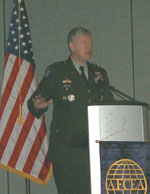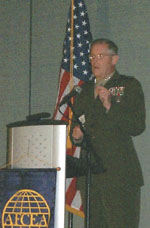Warfighters Highlight Collaboration Needs
Experts explore key issues relating to transformation, joint and coalition information sharing. 
Lt. Gen. Michael D. Maples, USA, director of the Defense Intelligence Agency, speaks about changes taking place in the military intelligence community.
Coordinating evolving operational and technical requirements between government agencies and allied nations was the focus of AFCEA’s Transformation TechNet 2006 conference and exposition. Held in
The event began with a morning keynote speech by Lt. Gen. Michael D. Maples,
This new strategic situation requires unprecedented speed and action because the nation and its allies’ enemies are flexible and networked. Effectively countering and defeating these foes necessitates a change from 20th century intelligence gathering and dissemination processes to a 21st century integration of functions, capabilities and allied nations contributing toward a unified purpose.
Gen. Maples explained that the U.S. Defense Department is shifting its emphasis from acquiring platforms such as tanks, guns, ships and aircraft to providing warfighters with timely and accurate information and knowledge. He added that platforms will continue to be important, but rapidly disseminated, timely battlefield information will make them more effective. “We’ve got to force the system to get intelligence into the hands of those who need it,” he maintained.
The general closed his speech by highlighting two DIA-backed initiatives: Joint Functional Component Command–Intelligence, Surveillance and Reconnaissance (JFCC-ISR) and intelligence campaign planning. The JFCC-ISR is a newly established headquarters designed to serve as a focal point for Defense Department global ISR situational awareness, planning and operations. Gen. Maples explained that the intelligence campaign planning effort refocuses Defense Department operational plans on human intelligence capabilities and that he is responsible for establishing standards that mesh with other
The day’s first panel focused on the issues and challenges facing interagency interoperability and collaboration. Panelists discussed the ongoing reorganization and changes as civilian and Defense Department intelligence organizations continue to share more data with each other. But these changes extend to government agencies not usually associated with information gathering. Moderator Dayton Maxwell, a senior adviser with the U.S. Agency for International Development (USAID), noted that the U.S. State Department and USAID now are working more closely with each other and the Defense Department to share data. He noted that intelligence gathering occurs more often in embassies than in
However, a flexible instead of doctrinaire response is necessary when collaborating in international operations. Dr. Joseph F. Bouchard, senior program executive, Zel Technologies LLC, and a retired U.S. Navy captain, explained that the government requires a range of skills sets because military operations can quickly become stabilization operations. During such missions, where requirements can shift suddenly, effective command and control is essential and naval platforms such as large deck amphibious assault ships can provide a communications hub for participating organizations, he noted.
A major part of interagency communication is not technology but an understanding of different organization’s cultures and how they interact, said Dr. Margaret Daly Hayes, a senior scientist with Evidence Based Research. She stated that agencies view time differently, with the military focusing on short-term, results-oriented goals while civilian agencies have longer time frames. For example, it is easy to impose order on a nation in chaos, but it takes much longer to establish true civil order, she said. Hayes offered that military agencies must be more equitable when working with civilian organizations and that flexibility to listen to other elements such as allied national governments and their agencies will help in such situations. “Collaboration trumps doctrine,” she said.
An international perspective on transformation was provided by luncheon speaker Adm. Mark Stanhope, KCB, OBE, RN, deputy supreme allied commander transformation. He shared that it is important for NATO to have a headquarters on
Adm. Stanhope noted that lessons from recent operations demonstrate that conflicts are unlikely to be resolved by military actions alone. NATO and its allies must focus on diplomatic solutions to solve current and future crises, he said. But technology presents complications because modern commercial communications systems allow increased scrutiny of missions and how they are carried out. The admiral warned that seemingly tactical acts could have global implications. He closed by explaining that NATO’s Allied Command Transformation is focusing on using effects-based operations that allow commanders to use a full spectrum of military, diplomatic and humanitarian solutions to increase the speed and precision of expeditionary operations.
The afternoon panel examined current trends in multinational experimentation. Discussion topics included ongoing initiatives to develop new force structures and operational techniques to allow coalition forces to work more effectively. Colin Wright, branch head of NATO Allied Command Transformation’s Research and Technology Coordination division, outlined the current status of the NATO response force (NRF). The NRF is a brigade-size force designed to deploy to a crisis area within a week to perform a variety of missions, from combat to humanitarian relief. However, the NRF is not a standing force. NATO nations assign units to participate in the NRF on a rotating basis. If a crisis occurs, they are rapidly assembled from a variety of units based on the best assets and platforms available to meet the nature of the crisis.
Cmdr. Bjorn Neurath, GE N, NATO Allied Command Transformation, operational experimentation, added that the NRF is undertaking a number of operational exercises this year prior to achieving full operational capability. The events will provide a range of missions—from tactical to strategic—and will operate in austere environments far from NATO bases. These efforts also will focus on achieving three goals: a coherent, effects-based approach to operations; decision superiority across all levels of NATO; and a concentration on areas key to the performance and effectiveness of the NRF.
 |
| Lt. Gen. Robert M. Shea, USMC, director for C4 systems (J-6), the Joint Staff, discusses configuration management issues faced by the U.S. Defense Department. |
Key issues include synchronizing joint C4 capabilities, assured information, network and information management, and spectrum. Regarding the synchronization of joint C4 capabilities, he noted that his command is seeking to finalize a joint plan to coordinate technology development across the services. This management is necessary because a system currently does not exist to measure how far a program is toward completion or how its progress compares with other services’ programs. The result is a lack of synchronization and one service receives a set of equipment before the others, he said.
Gen. Shea’s command also is addressing configuration management for command and control systems. He explained that this is a critical issue because when systems are not configured latency issues emerge when sending critical information to warfighters. The general closed by noting that spectrum issues represent the tip of an iceberg and his command is seeking ways to provide managers with better tools to resolve spectrum concerns.
 |
| Network security and secure collaboration are discussed during a panel moderated by AFCEA International President and Chief Executive Officer Vice Adm. Herbert A. Browne, USN (Ret.) (standing at podium). Participants were (l-r) Monica R. Shephard, director, joint prototype pathway, joint experimentation, U.S. Joint Forces Command; Maj. Gen. Marilyn A. Quagliotti, USA, vice director, Defense Information Systems Agency; Vice Adm. James D. McArthur Jr., USN, commander, Naval Network Warfare Command; and Brig. Gen. George J. Allen, USMC, director for command, control, communications and computers (C4), and chief information officer, U.S. Marine Corps. |
Responding to a question about the key technologies required to improve international network centricity and collaboration, Monica R. Shephard, director, joint prototype pathway, joint experimentation, JFCOM, noted that service-oriented architectures already have proven themselves to be reliable and that proximity computing could deliver massive computing capabilities to coalition forces. She added that other technologies with great potential for multinational information sharing include cognition management, open standards and technology development that are based on information technology open sourcing, library sciences and pattern recognition to identify behaviors.
When asked how large and small firms should move from a concept to delivering a service to warfighters, Brig. Gen. George J. Allen, USMC, director of C4 and chief information officer of the U.S. Marine Corps, cited Gen. Shea’s NCCOE efforts. Gen. Allen explained that companies such as Google put their new software capabilities on a Web site and invite beta users to test them. The NCCOE will create a federated certification area where beta users can use new software products to speed network rollout. This process represents a culture change for the Marine Corps, but the general sees no other way for the military to keep up with changing commercial technology standards.
Luncheon speaker Lt. Gen. John R. Wood,
But supporting the military’s transformation to a joint force presents challenges. Impediments include organizational design issues created by legacy organizational structures, capabilities issues for software tools, processes to change operational procedures, authorities to determine what rules are no longer necessary and concepts to provide operational guidelines. Gen. Wood added that JFCOM is examining a joint force support component command to manage joint logistics issues to move beyond service-specific supply chains.
The event’s final panel explored issues associated with architecture standardization and collaboration and how government organizations are responding to Defense Department transformation requirements. “Transformation is hard,” explained Col. Rory S. Kinney, USAF, chief, Architecture and Technology Division, and deputy chief of staff for communications, U.S. Air Force Headquarters. The colonel noted that the Air Force has taken an aggressive approach to change how it operates and manages its network architecture. This effort is divided into two areas, business and performance. These categories allow the service to subcategorize requirements into a variety of activities. He added that the Air Force currently is undertaking this process with internal data transparency teams that are focusing on streamlining business activities and performance outcomes.
Ron Vandiver, director, Architecture Integration and Management Directorate, U.S. Army Training and Doctrine Command, noted that architecture requires a common standard to permit data sharing among the services. This structure demands that architecture collaboration be administered from “cradle to grave” during a program’s life. Vandiver added that the main network collaboration community is not among the system’s architects but among the users. Because no standards currently are in place, coordinated architecture development is not defined. He noted that the Army is developing a capability integration map, however, that is designed to outline its network requirements.



